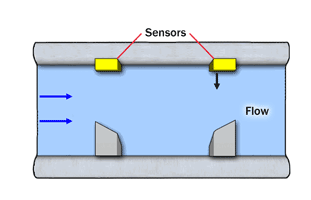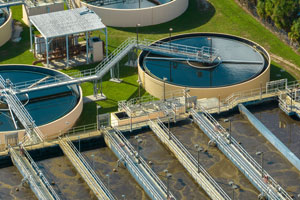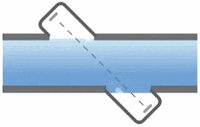How Ultrasonic Flowmeters Work
Ultrasonic flowmeters use sound waves to determine the velocity of a fluid flowing in a pipe. At no flow conditions, the frequencies of an ultrasonic wave transmitted into a pipe and its reflections from the fluid are the same. Under flowing conditions, the frequency of the reflected wave is different due to the Doppler effect. When the fluid moves faster, the frequency shift increases linearly. The transmitter processes signals from the transmitted wave and its reflections to determine the flow rate.

Transit time ultrasonic flowmeters send and receive ultrasonic waves between transducers in both the upstream and downstream directions in the pipe. At no flow conditions, it takes the same time to travel upstream and downstream between the transducers. Under flowing conditions, the upstream wave will travel slower and take more time than the (faster) downstream wave. When the fluid moves faster, the difference between the upstream and downstream times increases. The transmitter processes upstream and downstream times to determine the flow rate. They represent about 12% of all flowmeters sold.
Pros/Cons
This technology can be very accurate and is used for custody transfer (meaning accounting accurately for an expensive fluid) of natural gas and petroleum liquids. High turndown (can read low as a percentage of the full scale or top reading), handles high pressures, is repeatable (consistent), handles extreme temperatures, can be used clamped to the outside of a pipe without penetration, is low maintenance, highly reliable and self-diagnosing. Disadvantages can include high cost, sensitivity to stray process vibrations, problems with pipe diameter change due to buildup, and clamp-on units having lower accuracy.
Ultrasonic flowmeters do not obstruct flow so they can be applied to sanitary, corrosive, and abrasive liquids. Some ultrasonic flowmeters use clamp-on transducers that can be mounted external to the pipe and do not have any wetted parts. Temporary flow measurements can be made using portable ultrasonic flowmeters with clamp-on transducers. Clamp-on transducers are especially useful when piping cannot be disturbed, such as in power and nuclear industry applications. In addition, clamp-on transducers can be used to measure flow without regard to materials of construction, corrosion, and abrasion issues. However attractive, the use of clamp-on transducers introduces additional ultrasonic interfaces that can affect the reliability and performance of these flowmeters. In particular, if not properly applied and maintained, attenuation of the ultrasonic signal can occur at the interfaces between the clamp-on transducers and the outside pipe walls, and between the inside pipe walls and the fluid.
Ultrasonic flowmeters are commonly available in sizes to 72 inches and larger.
How to Use Ultrasonic Flowmeters
Ultrasonic flowmeters can be applied to measure the velocity of liquids that allow ultrasonic waves to pass, such as water, molten sulfur, cryogenic liquids, and chemicals. Transit time designs are also available to measure gas and vapor flow. Be careful because fluids that do not pass ultrasonic energy, such as many types of slurry, limit the penetration of ultrasonic waves into the fluid. In Doppler ultrasonic flowmeters, opaque fluids can limit ultrasonic wave penetration too near the pipe wall, which can degrade accuracy and/or cause the flowmeter to fail to measure. Transit time ultrasonic flowmeters can fail to operate when an opaque fluid weakens the ultrasonic wave to such an extent that the wave does not reach the receiver.
Industries Where Used

Ultrasonic flowmeters are most often used in industries such as oil and gas, water and wastewater, power, chemical, food and beverage, pharmaceutical, metals and mining, and pulp and paper.
Application Cautions for Ultrasonic Flowmeters
For transit time ultrasonic flowmeters, be sure that the fluid can adequately conduct ultrasonic waves, because the flowmeter will not measure when the ultrasonic waves cannot penetrate the flow stream between the transducers. Similarly, ultrasonic waves must be able to penetrate the fluid for Doppler flowmeters to operate accurately. When the fluid is relatively opaque and does not penetrate the fluid, Doppler flowmeters tend to measure the velocity of the fluid at or near the pipe wall, which can cause significant measurement error and/or cause the flowmeter to fail.
For Doppler ultrasonic flowmeters, be sure that the fluid adequately reflects ultrasonic waves, because the flowmeter will not operate without a reflected ultrasonic signal. Depending upon design, reflections can occur due to small bubbles of gas in the flow stream or the presence of eddies in the flow stream. If not already present in the flowing stream, generating these sources of reflection can be difficult in practice. Fortunately, some combination of bubbles of gas and/or eddies are present in most applications.
The velocity of the solid particles in slurry can be different than its liquid carrier fluid. Be careful applying ultrasonic technology when the solid particles can become concentrated in one part of the flowing stream, such as in a horizontal pipe flowing at a relatively low velocity. Be careful when applying Doppler ultrasonic flowmeters in slurry applications because the solid particles can produce strong signals that can cause the Doppler flowmeter to measure the velocity of the solids and not the velocity of the liquid.
Avoid fluids that can coat wetted transducers or coat the pipe wall in front of non-wetted transducers because the flowmeter will not measure when the ultrasonic waves cannot enter the flow stream. Be sure to maintain reliable clamp-on transducer connections to the pipe wall because the flowmeter will not measure when the ultrasonic waves are not able to reach the fluid.
Be sure to understand the process and apply these flowmeters properly. For example, a periodic cleaning process upstream may cause the flowmeter to stop working because the dirt may not allow ultrasonic energy to pass through the fluid. Further, if the dirt coats wetted transducers, the flowmeter may fail to operate until it is cleaned.
To learn more or to order any of Dwyer’s ultrasonic flowmeters, please visit our website at: https://dwyer-inst.com/en/products/flow/flow-transmitters/ultrasonic.html
—
Source: https://www.flowmeters.com/

Visa
adgoxmh
[url=http://www.gcypj3dc3oz7v3x18g3z90408gvp4594s.org/]udgoxmh[/url]
dgoxmh http://www.gcypj3dc3oz7v3x18g3z90408gvp4594s.org/
How Ultrasonic Flowmeters Work– Signal2U
[url=http://www.g1860ap42nogb015zln9m10p16iqf53ps.org/]uhyyntffdie[/url]
hyyntffdie http://www.g1860ap42nogb015zln9m10p16iqf53ps.org/
ahyyntffdie
2axgsr
How Ultrasonic Flowmeters Work– Signal2U
apiecoytqzg
[url=http://www.gj10y29jd0p2hfh7d34y648uur370n2ds.org/]upiecoytqzg[/url]
piecoytqzg http://www.gj10y29jd0p2hfh7d34y648uur370n2ds.org/
How Ultrasonic Flowmeters Work– Signal2U
aetobhvopff
[url=http://www.gjl8n85318q3woq4d59but38i4m1q21ys.org/]uetobhvopff[/url]
etobhvopff http://www.gjl8n85318q3woq4d59but38i4m1q21ys.org/